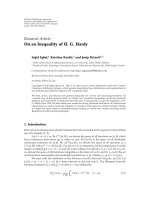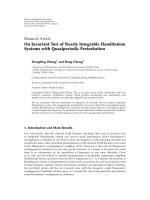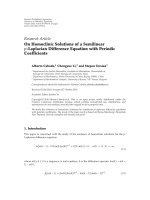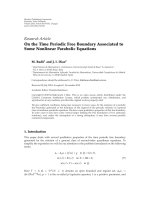Báo cáo hóa học: " Research Article On the Identities of Symmetry for the ζ-Euler Polynomials of Higher Order" pptx
Bạn đang xem bản rút gọn của tài liệu. Xem và tải ngay bản đầy đủ của tài liệu tại đây (500.31 KB, 9 trang )
Hindawi Publishing Corporation
Advances in Difference Equations
Volume 2009, Article ID 273545, 9 pages
doi:10.1155/2009/273545
Research Article
On the Identities of Symmetry for the ζ-Euler
Polynomials of H igher Order
Taekyun Kim,
1
Kyoung Ho Park,
2
and Kyung-won Hwang
3
1
Division of General Education-Mathematics, Kwangwoon University, Seoul 139-701, South Korea
2
Department of Mathematics, Sogang University, Seoul 121-742, South Korea
3
Department of General Education, Kookmin University, Seoul 139-702, South Korea
Correspondence should be addressed to Taekyun Kim,
Received 19 February 2009; Revised 31 May 2009; Accepted 18 June 2009
Recommended by Agacik Zafer
The main purpose of this paper is to investigate several further interesting properties of symmetry
for the multivariate p-adic fermionic integral on
Z
p
. From these symmetries, we can derive some
recurrence identities for the ζ-Euler polynomials of higher order, which are closely related to
the Frobenius-Euler polynomials of higher order. By using our identities of symmetry for the ζ-
Euler polynomials of higher order, we can obtain many identities related to the Frobenius-Euler
polynomials of higher order.
Copyright q 2009 Taekyun Kim et al. This is an open access article distributed under the Creative
Commons Attribution License, which permits unrestricted use, distribution, and reproduction in
any medium, provided the original work is properly cited.
1. Introduction/Definition
Let p be a fixed odd prime number. Throughout this paper, Z
p
, Q
p
, C, and C
p
will, respectively,
denote the ring of p-adic rational integer, the field of p-adic rational numbers, the complex
number field, and the completion of algebraic closure of Q
p
.Letv
p
be the normalized
exponential valuation of C
p
with |p|
p
p
−v
p
p
p
−1
.LetUDZ
p
be the space of uniformly
differentiable functions on Z
p
. For f ∈ UDZ
p
, q ∈ C
p
with |1 − q|
p
< 1, the fermionic p-adic
q-integral on Z
p
is defined as
I
−q
f
Z
p
f
x
dμ
−q
x
lim
N →∞
1 q
1 q
p
N
p
N
−1
x0
f
x
−q
x
1.1
see 1. Let us define the fermionic p-adic invariant integral on Z
p
as follows:
I
−1
f
lim
q → 1
I
−q
f
Z
p
f
x
dμ
−1
x
1.2
2 Advances in Difference Equations
see 1–8.From1.2, we have
I
−1
f
1
I
−1
f
2f
0
1.3
see 9, 10, where f
1
xfx 1. For ζ ∈ C
p
with |1 − ζ|
p
< 1, let fxe
xt
ζ
x
. Then, we
define the ζ-Euler numbers as follows:
Z
p
ζ
x
e
xt
dμ
−1
x
2
ζe
t
1
∞
n0
E
n,ζ
t
n
n!
, 1.4
where E
n,ζ
are called the ζ-Euler numbers. We can show that
2
ζe
t
1
1 ζ
−1
e
t
ζ
−1
·
2
1 ζ
2
1 ζ
∞
n0
H
n
−ζ
−1
t
n
n!
, 1.5
where H
n
−ζ
−1
are the Frobenius-Euler numbers. By comparing the coefficients on both sides
of 1.4 and 1.5,weseethat
E
n,ζ
2
1 ζ
H
n
−ζ
−1
. 1.6
Now, we also define the ζ-Euler polynomials as follows:
2
ζe
t
1
e
xt
∞
n0
E
n,ζ
x
t
n
n!
. 1.7
In the viewpoint of 1.5, we can show that
2
ζe
t
1
e
xt
e
xt
1 ζ
−1
e
t
ζ
−1
·
2
1 ζ
2
1 ζ
∞
n0
H
n
−ζ
−1
,x
t
n
n!
, 1.8
where H
n
−ζ
−1
,x are the nth Frobenius-Euler polynomials. From 1.7 and 1.8,wenote
that
E
n,ζ
x
2
1 ζ
H
n
−ζ
−1
,x
1.9
cf. 1–8, 11–18. For each positive integer k,letT
k,ζ
n
n
0
−1
ζ
k
. Then we have
∞
k0
T
k,ζ
n
t
k
k!
∞
k0
n
0
−1
k
ζ
t
k
k!
n
0
−1
ζ
e
t
1
−1
n1
e
n1
t
ζe
t
1
. 1.10
Advances in Difference Equations 3
The ζ-Euler polynomials of order k, denoted E
k
n,ζ
x, are defined as
e
xt
2
ζe
t
1
k
2
ζe
t
1
×···×
2
ζe
t
1
e
xt
∞
n0
E
k
n,ζ
x
t
n
n!
. 1.11
Then the values of E
k
n,ζ
x at x 0 are called the ζ-Euler numbers of order k. When k 1,
the polynomials or numbers are called the ζ-Euler polynomials or numbers. The purpose of
this paper is to investigate some properties of symmetry for the multivariate p-adic fermionic
integral on Z
p
. From the properties of symmetry for the multivariate p-adic fermionic integral
on Z
p
, we derive some identities of symmetry for the ζ-Euler polynomials of higher order. By
using our identities of symmetry for the ζ-Euler polynomials of higher order, we can obtain
many identities related to the Frobenius-Euler polynomials of higher order.
2. On the Symmetry for the ζ-Euler Polynomials of Higher Order
Let w
1
,w
2
∈ N with w
1
≡ 1mod 2 and w
2
≡ 1mod 2. Then we set
R
m
w
1
,w
2
Z
m
p
e
w
1
x
1
x
2
···x
m
w
2
xt
ζ
w
1
x
1
···w
1
x
m
dμ
−1
x
1
···dμ
−1
x
m
Z
p
ζ
w
1
w
2
x
e
w
1
w
2
xt
dμ
−1
x
×
Z
m
p
e
w
2
x
1
x
2
···x
m
w
1
yt
ζ
w
2
x
1
···w
2
x
m
dμ
−1
x
1
···dμ
−1
x
m
,
2.1
where
Z
m
p
f
x
1
, ,x
m
dμ
−1
x
1
···dμ
−1
x
m
Z
p
···
Z
p
f
x
1
, ,x
m
dμ
−1
x
1
···dμ
−1
x
m
. 2.2
Thus, we note that this expression for R
m
w
1
,w
2
is symmetry in w
1
and w
2
.From2.1 ,we
have
R
m
w
1
,w
2
Z
m
p
e
w
1
x
1
···x
m
t
ζ
w
1
x
1
···w
1
x
m
dμ
−1
x
1
···dμ
−1
x
m
e
w
1
w
2
xt
×
⎛
⎝
Z
p
e
w
2
x
m
t
ζ
w
2
x
m
dμ
−1
x
m
Z
p
e
w
1
w
2
xt
ζ
w
1
w
2
x
dμ
−1
x
⎞
⎠
×
Z
m−1
p
e
w
2
x
1
···x
m−1
t
ζ
w
2
x
1
···w
2
x
m−1
dμ
−1
x
1
···dμ
−1
x
m−1
e
w
1
w
2
yt
.
2.3
4 Advances in Difference Equations
We can show that
Z
p
e
xt
ζ
x
dμ
−1
x
Z
p
e
w
1
xt
ζ
w
1
x
dμ
−1
x
w
1
−1
0
−1
ζ
e
t
∞
k0
T
k,ζ
w
1
− 1
t
k
k!
. 2.4
By 1.4 and 1.11,weseethat
Z
m
p
e
w
1
x
1
···x
m
t
ζ
w
1
x
1
···w
1
x
m
dμ
−1
x
1
···dμ
−1
x
m
e
w
1
w
2
xt
2
ζ
w
1
e
w
1
t
1
m
e
w
1
w
2
xt
∞
n0
E
m
n,ζ
w
1
w
2
x
w
n
1
t
n
n!
.
2.5
Thus, we have
E
m
n,ζ
w
1
w
2
x
n
0
n
E
m
,ζ
w
1
w
n−
2
x
n−
. 2.6
From 2.3, 2.4,and2.5, we can derive
R
m
w
1
,w
2
∞
0
E
m
,ζ
w
1
w
2
x
w
1
t
!
∞
k0
T
k,ζ
w
2
w
1
− 1
w
k
2
k!
t
k
∞
i0
E
m−1
i,ζ
w
2
w
1
y
w
i
2
i!
t
i
∞
0
E
m
,ζ
w
1
w
2
x
w
1
t
!
⎛
⎝
∞
j0
⎛
⎝
j
k0
T
k,ζ
w
2
w
1
− 1
w
k
2
w
j−k
2
E
m−1
j−k
w
1
y
k!
j − k
!
j!
⎞
⎠
t
j
j!
⎞
⎠
∞
0
E
m
,ζ
w
1
w
2
x
w
1
t
!
⎛
⎝
∞
j0
j
k0
T
k,ζ
w
2
w
1
− 1
j
k
E
m−1
j−k,ζ
w
2
w
1
y
w
j
2
⎞
⎠
t
j
j!
∞
n0
⎛
⎝
n
j0
j
k0
T
k,ζ
w
2
w
1
− 1
j
k
E
m−1
j−k,ζ
w
2
w
1
y
w
j
2
w
n−j
1
n − j
!j!
E
m
n−j,ζ
w
1
w
2
x
n!
⎞
⎠
t
n
n!
∞
n0
⎛
⎝
n
j0
n
j
w
j
2
w
n−j
1
E
m
n−j,ζ
w
1
w
2
x
j
k0
T
k,ζ
w
2
w
1
− 1
j
k
E
m−1
j−k,ζ
w
2
w
1
y
⎞
⎠
t
n
n!
.
2.7
Advances in Difference Equations 5
By the same method, we also see that
R
m
w
1
,w
2
Z
m
p
e
w
2
x
1
···x
m
t
ζ
w
2
x
1
···w
2
x
m
dμ
−1
x
1
···dμ
−1
x
m
e
w
1
w
2
xt
×
⎛
⎝
Z
p
e
w
1
x
m
t
ζ
w
1
x
m
dμ
−1
x
m
Z
p
e
w
1
w
2
xt
ζ
w
1
w
2
x
dμ
−1
x
⎞
⎠
×
Z
m−1
p
e
w
1
x
1
···x
m−1
t
ζ
w
1
x
1
···w
1
x
m−1
dμ
−1
x
1
···dμ
−1
x
m−1
e
w
1
w
2
yt
∞
0
E
m
,ζ
w
2
w
1
x
w
2
t
!
∞
k0
T
k,ζ
w
1
w
2
− 1
w
k
1
t
k
k!
∞
i0
E
m−1
i,ζ
w
1
w
2
y
w
i
1
t
i
i!
∞
0
E
m
,ζ
w
2
w
1
x
w
2
t
!
⎛
⎝
∞
j0
⎛
⎝
j
k0
T
k,ζ
w
1
w
2
− 1
k!
E
m−1
j−k
w
2
y
j − k
!
⎞
⎠
w
j
1
t
j
⎞
⎠
∞
0
E
m
,ζ
w
2
w
1
x
w
2
t
!
⎛
⎝
∞
j0
⎛
⎝
j
k0
T
k,ζ
w
1
w
2
− 1
E
m−1
j−k
w
2
y
k!
j − k
!
j!
⎞
⎠
w
j
1
t
j
j!
⎞
⎠
∞
0
E
m
,ζ
w
2
w
1
x
w
2
t
!
⎛
⎝
∞
j0
j
k0
j
k
T
k,ζ
w
1
w
2
− 1
E
m−1
j−k,ζ
w
1
w
2
y
w
j
1
t
j
j!
⎞
⎠
∞
n0
⎛
⎝
n
j0
j
k0
j
k
T
k,ζ
w
1
w
2
− 1
E
m−1
j−k,ζ
w
1
w
2
y
w
j
1
w
n−j
2
j!
n − j
!
E
m
n−j,ζ
w
2
w
1
x
n!
⎞
⎠
t
n
n!
∞
n0
⎛
⎝
n
j0
n
j
w
j
1
w
n−j
2
E
m
n−j,ζ
w
2
w
1
x
j
k0
j
k
T
k,ζ
w
1
w
2
− 1
E
m−1
j−k,ζ
w
1
w
2
y
⎞
⎠
t
n
n!
.
2.8
By comparing the coefficients on both sides of 2.7 and 2.8, we obtain the following.
Theorem 2.1. For w
1
,w
2
∈ N with w
1
≡ 1mod 2 , w
2
≡ 1mod 2 , and n ≥ 0,m ≥ 1, one has
n
j0
n
j
w
j
2
w
n−j
1
E
m
n−j,ζ
w
1
w
2
x
j
k0
T
k,ζ
w
2
w
1
− 1
j
k
E
m−1
j−k,ζ
w
2
w
1
y
n
j0
n
j
w
j
1
w
n−j
2
E
m
n−j,ζ
w
2
w
1
x
j
k0
j
k
T
k,ζ
w
1
w
2
− 1
E
m−1
j−k,ζ
w
1
w
2
y
.
2.9
6 Advances in Difference Equations
Let y 0andm 1in2.9. Then we have
n
j0
n
j
w
n−j
1
w
j
2
E
n−j,ζ
w
1
w
2
x
T
k,ζ
w
2
w
1
− 1
n
j0
n
j
w
j
1
w
n−j
2
E
n−j,ζ
w
2
w
1
x
T
k,ζ
w
1
w
2
− 1
.
2.10
From 2.10,wenotethat
n
i0
n
i
w
i
1
w
n−i
2
E
i,ζ
w
1
w
2
x
T
n−i,ζ
w
2
w
1
− 1
n
i0
n
i
w
n−i
1
w
i
2
E
i,ζ
w
2
w
1
x
T
n−i,ζ
w
1
w
2
− 1
.
2.11
If we take w
2
1in2.11, then we have
E
n,ζ
w
1
x
n
i0
n
i
w
i
1
E
i,ζ
w
1
x
T
n−i,ζ
w
1
− 1
. 2.12
From 2.3,wenotethat
R
m
w
1
,w
2
Z
m
p
e
w
1
x
1
···x
m
t
ζ
w
1
x
1
···w
1
x
m
dμ
−1
x
1
···dμ
−1
x
m
e
w
1
w
2
xt
×
⎛
⎝
Z
p
e
w
2
x
m
t
ζ
w
2
x
m
dμ
−1
x
m
Z
p
e
w
1
w
2
xt
ζ
w
1
w
2
x
dμ
−1
x
⎞
⎠
×
Z
m−1
p
e
w
2
x
1
···x
m−1
t
ζ
w
2
x
1
···w
2
x
m−1
dμ
−1
x
1
···dμ
−1
x
m−1
e
w
1
w
2
yt
Z
m
p
e
w
1
x
1
···x
m
t
ζ
w
1
x
1
···w
1
x
m
dμ
−1
x
1
···dμ
−1
x
m
e
w
1
w
2
xt
×
w
1
−1
i0
−1
i
e
w
2
it
ζ
w
2
i
×
Z
m−1
p
e
w
2
x
1
···x
m−1
t
ζ
w
2
x
1
···w
2
x
m−1
dμ
−1
x
1
···dμ
−1
x
m−1
e
w
1
w
2
yt
Advances in Difference Equations 7
w
1
−1
i0
−1
i
ζ
w
2
i
Z
m
p
e
w
1
x
1
···x
m
w
2
/w
1
iw
2
xt
ζ
w
1
x
1
···w
1
x
m
dμ
−1
x
1
···dμ
−1
x
m
×
Z
m−1
p
e
w
2
x
1
···x
m−1
w
1
yt
ζ
w
2
x
1
···w
2
x
m−1
dμ
−1
x
1
···dμ
−1
x
m−1
w
1
−1
i0
−1
i
ζ
w
2
i
∞
k0
E
m
k,ζ
w
1
w
2
w
1
i w
2
x
w
k
1
t
k
k!
∞
0
E
m−1
,ζ
w
2
w
1
y
w
2
t
!
∞
n0
n
k0
w
1
−1
i0
−1
i
ζ
w
2
i
E
m
k,ζ
w
1
w
2
x
w
2
w
1
i
w
k
1
k!
E
m−1
n−k,ζ
w
2
w
1
y
w
n−k
2
n − k
!
n!
t
n
n!
∞
n0
n
k0
n
k
w
k
1
w
n−k
2
E
m−1
n−k,ζ
w
2
w
1
y
w
1
−1
i0
−1
i
ζ
w
2
i
E
m
k,ζ
w
1
w
2
x
w
2
w
1
i
t
n
n!
.
2.13
By the symmetric property of R
m
w
1
,w
2
in w
1
,w
2
,wealsoseethat
R
m
w
1
,w
2
Z
m
p
e
w
2
x
1
···x
m
t
ζ
w
2
x
1
···x
m
dμ
−1
x
1
···dμ
−1
x
m
e
w
1
w
2
xt
×
⎛
⎝
Z
p
e
w
1
x
m
t
ζ
w
1
x
m
dμ
−1
x
m
Z
p
e
w
1
w
2
xt
ζ
w
1
w
2
x
dμ
−1
x
⎞
⎠
×
Z
m−1
p
e
w
1
x
1
···x
m−1
t
ζ
w
1
x
1
···x
m−1
dμ
−1
x
1
···dμ
−1
x
m−1
e
w
1
w
2
yt
Z
m
p
e
w
2
x
1
···x
m
t
ζ
w
2
x
1
···x
m
dμ
−1
x
1
···dμ
−1
x
m
e
w
1
w
2
xt
×
w
2
−1
i0
−1
i
e
w
1
it
ζ
w
1
i
×
Z
m−1
p
e
w
1
x
1
···x
m−1
w
2
yt
ζ
w
1
x
1
···x
m−1
dμ
−1
x
1
···dμ
−1
x
m−1
w
2
−1
i0
−1
i
ζ
w
1
i
Z
m
p
e
w
2
x
1
···x
m
w
1
/w
2
iw
1
xt
ζ
w
2
x
1
···x
m
dμ
−1
x
1
···dμ
−1
x
m
×
Z
m−1
p
e
w
1
x
1
···x
m−1
w
2
yt
ζ
w
1
x
1
···w
1
x
m−1
dμ
−1
x
1
···dμ
−1
x
m−1
w
2
−1
i0
−1
i
ζ
w
1
i
∞
k0
E
m
k,ζ
w
2
w
1
w
2
i w
1
x
w
k
2
t
k
k!
∞
0
E
m−1
,ζ
w
1
w
2
y
w
1
t
!
8 Advances in Difference Equations
∞
n0
n
k0
w
2
−1
i0
−1
i
ζ
w
1
i
E
m
k,ζ
w
2
w
1
x
w
1
w
2
i
w
k
2
k!
E
m−1
n−k
w
2
y
w
n−k
1
n − k
!
n!
t
n
n!
∞
n0
n
k0
n
k
w
k
2
w
n−k
1
E
m−1
n−k,ζ
w
1
w
2
y
w
2
−1
i0
−1
i
ζ
w
1
i
E
m
k,ζ
w
2
w
1
x
w
1
w
2
i
t
n
n!
.
2.14
By comparing the coefficients on both sides of 2.13 and 2.14, we obtain the following
theorem.
Theorem 2.2. For w
1
,w
2
∈ N with w
1
≡ 1mod 2 and w
2
≡ 1mod 2 , one has
n
k0
n
k
w
k
1
w
n−k
2
E
m−1
n−k,ζ
w
2
w
1
y
w
1
−1
i0
−1
i
ζ
w
2
i
E
m
k,ζ
w
1
w
2
x
w
2
w
1
i
n
k0
n
k
w
k
2
w
n−k
1
E
m−1
n−k,ζ
w
1
w
2
y
w
2
−1
i0
−1
i
ζ
w
1
i
E
m
k,ζ
w
2
w
1
x
w
1
w
2
i
.
2.15
Let y 0andm 1, we have
w
n
1
w
1
−1
i0
−1
i
ζ
w
2
i
E
n,ζ
w
1
w
2
x
w
2
w
1
i
w
n
2
w
2
−1
i0
−1
i
ζ
w
1
i
E
n,ζ
w
2
w
1
x
w
1
w
2
i
. 2.16
From 2.16, we can derive
w
1
−1
i0
−1
i
ζ
i
E
n,ζ
w
1
x
1
w
1
i
1
w
n
1
E
n,ζ
w
1
x
. 2.17
Acknowledgment
The present research has been conducted by the research grant of the Kwangwoon University
in 2009.
References
1 T. Kim, “Symmetry p-adic invariant integral on Z
p
for Bernoulli and Euler polynomials,” Journal of
Difference Equations and Applications, vol. 14, no. 12, pp. 1267–1277, 2008.
2 T. Kim, “Note on the Euler numbers and polynomials,” Advanced Studies in Contemporary Mathematics,
vol. 17, no. 2, pp. 131–136, 2008.
3 T. Kim, “Note on q-Genocchi numbers and polynomials,” Advanced Studies in Contemporary
Mathematics, vol. 17, no. 1, pp. 9–15, 2008.
4 T. Kim, “The modified q-Euler numbers and polynomials,” Advanced Studies in Contemporary
Mathematics, vol. 16, no. 2, pp. 161–170, 2008.
5 T. Kim, “On a q-analogue of the p-adic log gamma functions and related integrals,” Journal of Number
Theory, vol. 76, no. 2, pp. 320–329, 1999.
Advances in Difference Equations 9
6 T. Kim, “q-Volkenborn integration,” Russian Journal of Mathematical Physics, vol. 9, no. 3, pp. 288–299,
2002.
7 T. Kim, “q-Bernoulli numbers and polynomials associated with Gaussian binomial coefficients,”
Russian Journal of Mathematical Physics, vol. 15, no. 1, pp. 51–57, 2008.
8 T. Kim, J. Y. Choi, and J. Y. Sug, “Extended q-Euler numbers and polynomials associated with
fermionic p-adic q-integral on
Z
p
,” Russian Journal of Mathematical Physics, vol. 14, no. 2, pp. 160–163,
2007.
9 T. Kim, “Symmetry of power sum polynomials and multivariate fermionic p-adic invariant integral
on
Z
p
,” Russian Journal of Mathematical Physics, vol. 16, no. 1, pp. 93–96, 2009.
10 T. Kim, “On p-adic interpolating function for q-Euler numbers and its derivatives,” Journal of
Mathematical Analysis and Applications, vol. 339, no. 1, pp. 598–608, 2008.
11 R. P. Agarwal and C. S. Ryoo, “Numerical computations of the roots of the generalized twisted q-
Bernoulli polynomials,” Neural, Parallel & Scientific Computations, vol. 15, no. 2, pp. 193–206, 2007.
12 M. Cenkci, M. Can, and V. Kurt, “p-adic interpolation functions and Kummer-type congruences for
q-twisted and q-generalized twisted Euler numbers,” Advanced Studies in Contemporary Mathematics,
vol. 9, no. 2, pp. 203–216, 2004.
13 F. T. Howard, “Applications of a recurrence for the Bernoulli numbers,” Journal of Number Theory, vol.
52, no. 1, pp. 157–172, 1995.
14 B. A. Kupershmidt, “Reflection symmetries of q-Bernoulli polynomials,” Journal of Nonlinear
Mathematical Physics, vol. 12, pp. 412–422, 2005.
15 H. Ozden and Y. Simsek, “Interpolation function of the h, q-extension of twisted Euler numbers,”
Computers & Mathematics with Applications, vol. 56, no. 4, pp. 898–908, 2008.
16 L C. Jang, “A study on the distribution of twisted q-Genocchi polynomials,” Advanced Studies in
Contemporary Mathematics, vol. 18, no. 2, pp. 181–189, 2009.
17 M. Schork, “Ward’s “calculus of sequences”, q-calculus and the limit q →−1,” Advanced Studies in
Contemporary Mathematics, vol. 13, no. 2, pp. 131–141, 2006.
18 H. J. H. Tuenter, “A symmetry of power sum polynomials and Bernoulli numbers,” The American
Mathematical Monthly, vol. 108, no. 3, pp. 258–261, 2001.









